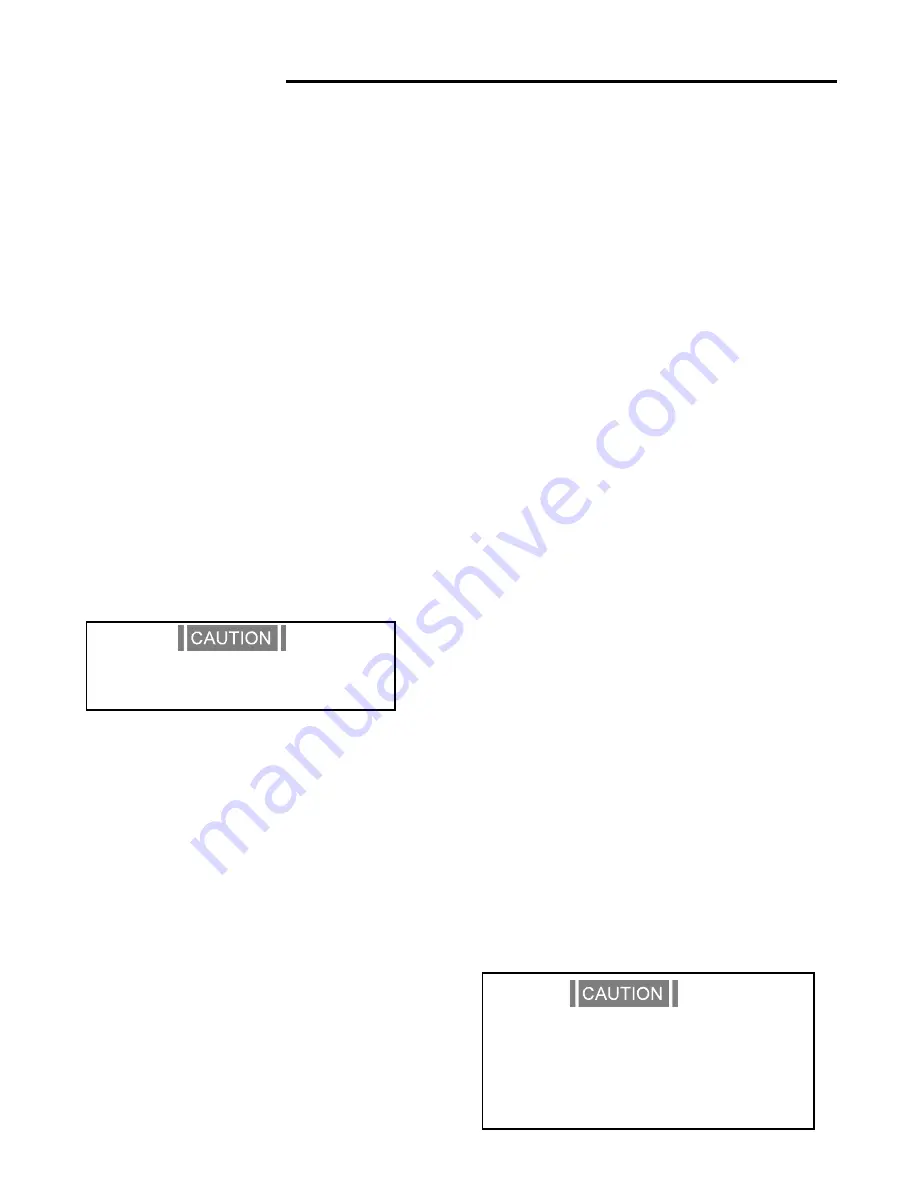
18
5—OPERATION
5.1—CHECK LIST
1. Fill the fuel tank with good quality, clean, diesel with a
minimum of 40 octane. Fresh fuel prevents gum from
forming in the fuel system. Fill tank to 1 inch (25 mm)
below filler neck. Do not overfill.
2. Check oil in the engine crankcase. It should be filled to
the full mark on the dipstick. Refer to Section 1.6 in this
manual for recommend oil viscosity.
3. Check all lubrication points outlined in the “Section 7.14
Lubrication” section of this manual. Check linkage for
traction pedal to the pump for wear or damage.
4. Check tires for proper inflation. Refer to section 1.4 of
this manual.
5. Check oil level in hydraulic reservoir. Oil level should be
level with the bottom of the screen when looking into the
fill neck and when unit is sitting on a level surface.
6. Check decks for desired cutting height. To provide a
satisfactory cut, it is essential for all decks be accurately
adjusted to exactly the same height. See 6.9 in the
Adjustments Section.
OPERATING SUGGESTIONS
Under no circumstances should the engine be
started with the operator or bystander standing
next to tractor or cutting units.
1. When starting the engine, the operator must be seated
on the seat, deck control switch must be
OFF
and
traction pedal must be in neutral (the center position).
2. The operator should practice mowing in an open clear
area, to become thoroughly familiar with the operation of
the tractor.
3. Never operate the mowers when they are in the up
position because of the dangers of flying objects and
exposed blades.
4. Plan your cutting pattern to avoid any unnecessary stops
or sharp, frequent turns. Study the area to determine the
best mowing procedure. Consider the height of the grass
and the type of terrain (level, hilly, or rough). Each
condition will require certain adjustments or precautions.
5. Before leaving the mower,
always lower deck mowers
so that when exiting the mower and stepping on the non-
skid pads of the wing mowers, it will not put excessive
strain on the lift mechanism.
6.
Operate at speeds which allow you to have complete
control of the tractor and allow you to stop the tractor or
maneuver safely in case of an emergency. It is
recommended that you adjust the Speed Control (6, Fig.
J), to maintain a constant pedal postion/speed and
reduce the operator fatigue.
7.
To obtain maximum mower life, the operator must use
discretion when mowing near gravel areas (roadway,
parking areas, cart paths etc.) By operating too close to
overlapping gravel areas, stones maybe picked up by
the mower and ejected under the deck causing wear to
the blades and damage from flying objects.
5.2— STARTING THE ENGINE
1.
Sit in operators seat.
2.
Place deck control switch in the “OFF” position (9, Fig
J).
3.
Place the traction pedal in “Neutral” position (5, Fig J).
4.
Engage parking brake (8, Fig J).
5.
Insert ignition key, turn clockwise to “run” position and
wait until the glow plug ON light turns off. Turn key
clockwise to “start” and release key when engine starts.
Do not hold key in “start” position for more than 15
seconds or damage to the starter may result. If engine
does not start within this time, release the key and wait
for a few minutes before trying again.
5.3—DRIVING THE TRACTOR
1. Position throttle at full throttle or slightly less for optimum
power and deck speed.
2. Release parking brake (8, Fig. J).
3. Moving forward: Push the toe of the traction pedal forward
with the ball of your foot, to increase the forward speed .
4. Moving backward: Push the heel of the traction pedal in
with the heel of your foot, to increase the reverse speed.
5. To return traction pedal to neutral, rock pedal with foot until
pedal stops. The pedal will stay in neutral when you
remove your foot.
To avoid possible loss of control and/or se-
rious bodily injury, avoid abrupt chages in
the tration pedal position. Reduce speed on
slopes, rough terrain, and in sharp turns to
prevent tipping or loss of contro
l.
Summary of Contents for I-TRIM
Page 2: ...2 ...
Page 8: ...8 F G H J I ...
Page 25: ...I TRIM 25 THIS PAGE IS BLANK ...
Page 34: ...34 ...
Page 35: ...I TRIM 35 ...
Page 36: ...36 FIGURE 1 23 4 5 3 6 7 8 9 10 11 12 13 15 16 19 20 2 1 18 21 17 22 24 ...
Page 42: ...42 FIGURE 4 4 1 2 26 5 6 7 8 9 10 11 12 13 14 15 16 17 18 19 20 21 22 23 24 25 27 28 29 3 29 ...
Page 45: ...I TRIM 45 FIGURE 5 PEDAL ASSY HYD PUMPS ...
Page 46: ...46 FIGURE 6A FIGURE 6B ...
Page 47: ...I TRIM 47 FIGURE 6A FRONT AXLE FUEL TANK AND FRAME FIGURE 6B FRONT WHEEL ASSY ...
Page 55: ...I TRIM 55 FIGURE 12 HYDRAULIC WHEEL MOTORS STEERING ...
Page 60: ...60 ...
Page 62: ...62 ...
















































